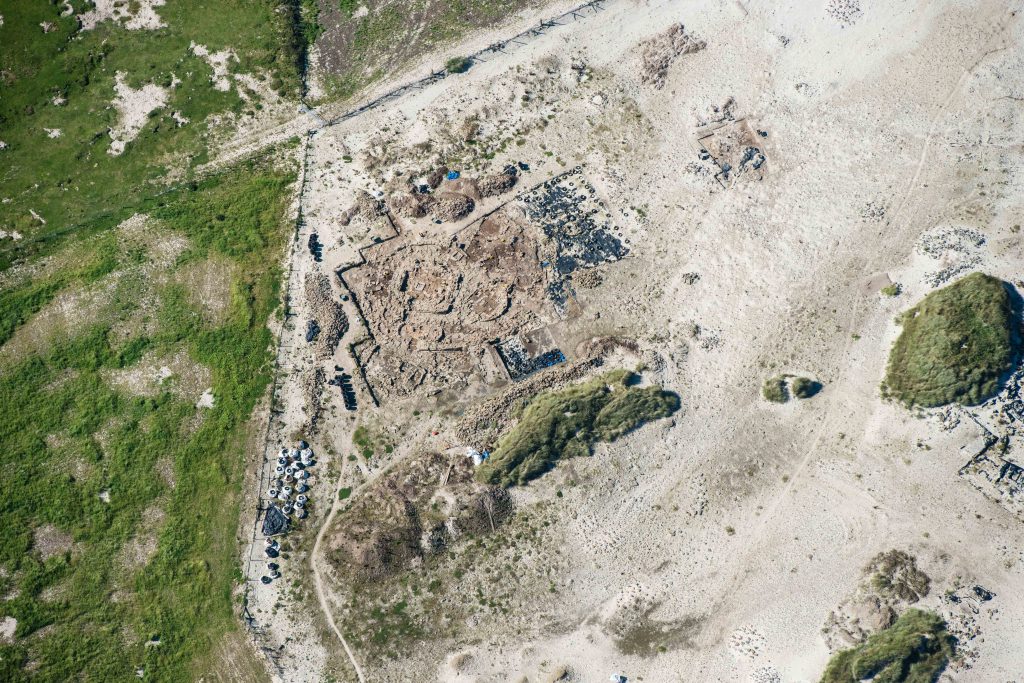Last month I unearthed my trowel and kneeling pad, and spent a few days working at the Links of Noltland.
It’s one of the most important sites to be excavated in recent years, and is made up of Late Neolithic and Bronze Age settlements, field systems and a cemetery.
The aim of this last phase of work is to fully excavate and record the later Neolithic structures that have been uncovered and to identify the extent of these remains. I spent the rest of the week working through the Neolithic midden in Area 5 , in search of the increasingly elusive enclosure wall which survives further to the south and arcs across towards this area, enclosing some of the earliest structures on the site.
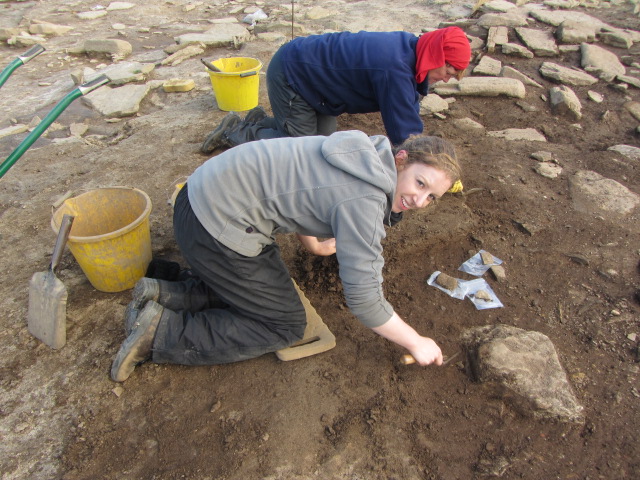
Hard at work
A quick history lesson
The first full season of excavation began in 2009 and recent digs have uncovered the remains of late Neolithic and Bronze Age settlements, field systems and burials. These date from around 3000 to 1000 BC.
So far around 30 structures and over 35,000 finds have been excavated giving us a better understanding of life and death in prehistoric Scotland.
The project has been a battle against time and the elements, which threaten to destroy the site. As the team heads into its final season of excavation, I was thrilled to have the opportunity to get my hands dirty and learn about the site in much more detail.
Arriving on Orkney
I arrived on site on a very grey and foggy morning to meet with Hazel and Graeme of EASE Archaeology, who directed the excavations on behalf of Historic Environment Scotland.
Before getting started, Graeme gave me a full tour of the site and talked me through a selection of the impressive finds. These included large fragments of decorated Grooved Ware pottery, numerous stone tools. Dressed stone slabs were also found from some of the structures with incised and pecked marks similar to those found at other sites such as Skara Brae and the Ness of Brodgar.
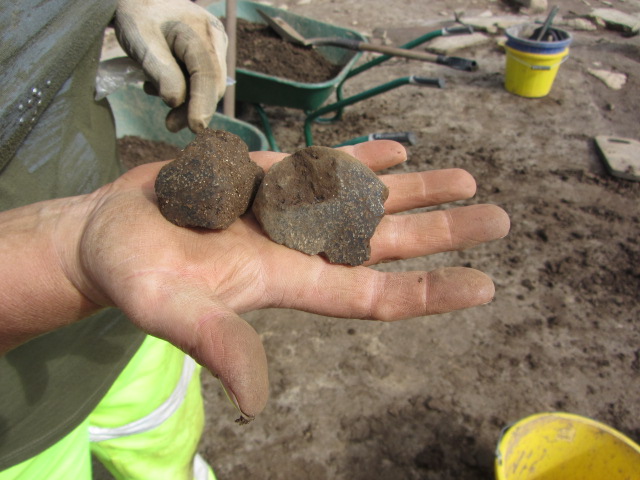
Examples of possible polished stone tools, broken by later ploughing.
Perhaps the most exciting recent find was a beautiful fragment of a polished stone axe, and a bone pendant found in one of the cells of the burnt mound.
The fog soon lifted and I settled into my work of trowelling back the heavily mixed layer of Bronze Age plough soil down to the late Neolithic midden deposits below. Working alongside me in this area were Anna, Dan and Emily, who form part of the small team of experienced archaeologists working on the site.
Neolithic rubbish
While the midden material may essentially just be Neolithic rubbish, it is an incredibly important resource for understanding the community that lived here. The animal bone can tell us about what people ate, the animals they kept or hunted, and agriculture and butchery practices.
The fragments of stone tools and pottery tell us about how these objects were made and used, the technology available and the types of activities which took place on site. Other environmental evidence such as shells, grain and pollen can tell us about the climate, people’s diets and agricultural practices.
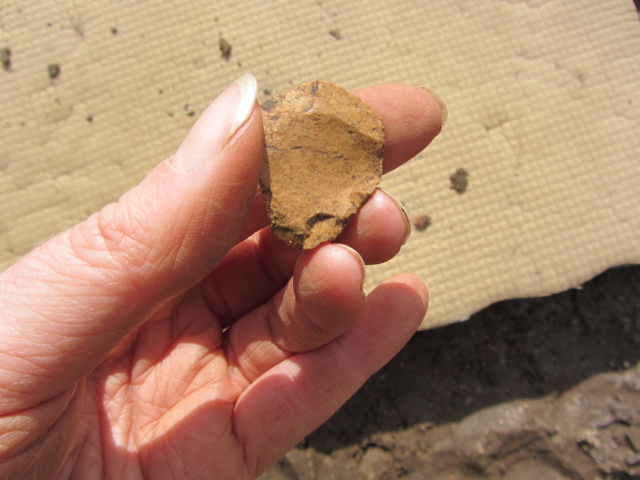
Flint thumb scraper found in the Neolithic midden deposit.
In the few days that I was on site this area revealed well over a hundred flint tools and flakes, as well as hammer stones and cores, hinting at a possible industrial or working area at the edge of the settlement.
Mysterious skulls…
To the south of this area, within the enclosure wall is Structure 10 . Another member of the team, Dawn, had been focused on unravelling the various phases of construction and alteration within this structure, removing the central hearth associated with the latest phase of occupation to reveal the earlier deposits below. Interestingly, the slabs making up the centre of the later hearth seem to have come from a stone door, perhaps once associated with an earlier passage in the house.
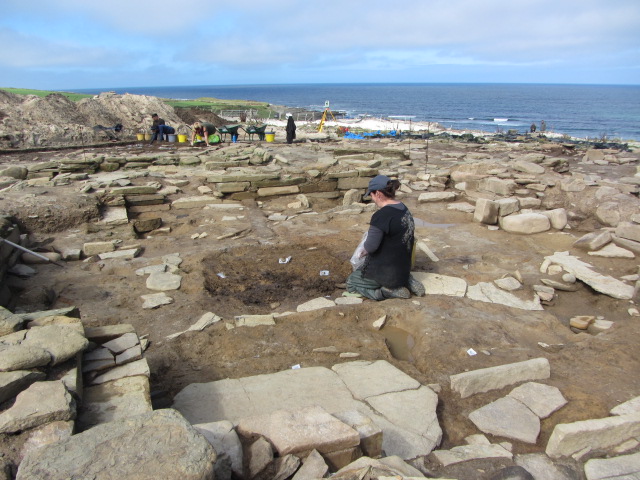
Dawn working on the hearth in the centre of Structure 10.
Just outside of Structure 10, Christoir has been excavating deposits built up against the enclosure wall. Over the last few years there have been many intriguing finds associated with the enclosure wall. These include a series of deliberately placed cattle skulls placed around the outside and more cattle and sheep skulls arranged on a platform within the enclosure wall.
I feel very lucky and privileged to have spent a few days working on the site and not just because of the views that Grobust beach has to offer!
The Links of Noltland is an incredibly important site as it provides valuable evidence for daily life and settlement not only in the late Neolithic, similar to Skara Brae, but perhaps more significantly for continued settlement through the Bronze Age. This long period of occupation, combined with the wealth of evidence from the burials found here provide us with an almost unparalleled insight into life and death of Neolithic and Bronze Age society in Scotland.
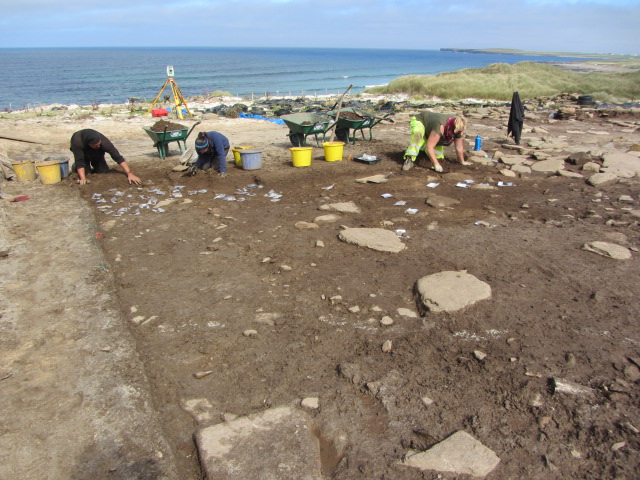
Dan, Anna and Emily uncovering the late Neolithic remains. The area on the left revealed a huge number of flint tools and flakes.
Follow our progress, and keep in touch
The dig is scheduled to continue until late September / early October. Visitors are very welcome to the site – or if you cannot make the trip, why not follow the excavations on Facebook or take an interactive aerial tour of the most recent excavations.
You can also find more about the dig, and the wider history and archaeology of Westray at the Westray Heritage Centre in Pierowall, where you can see a selection of artefacts from the site including the Westray Wife and other figurines.
The rescue excavations are commissioned by Historic Environment Scotland in response to catastrophic dune deflation and are being undertaken by EASE Archaeology.
This blog is part of our Scottish Archaeology Month coverage. Subscribe to be notified of the latest posts.

